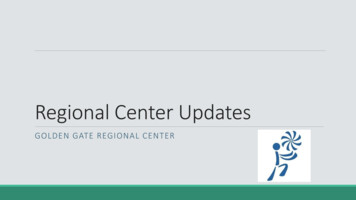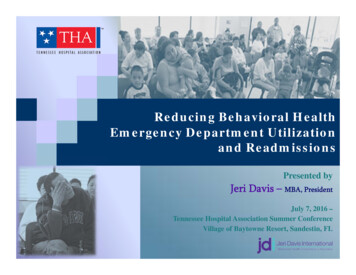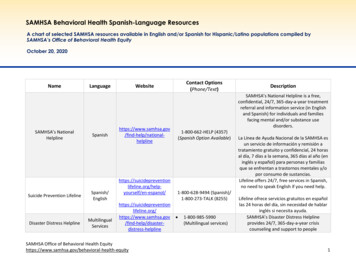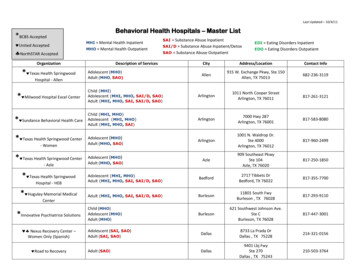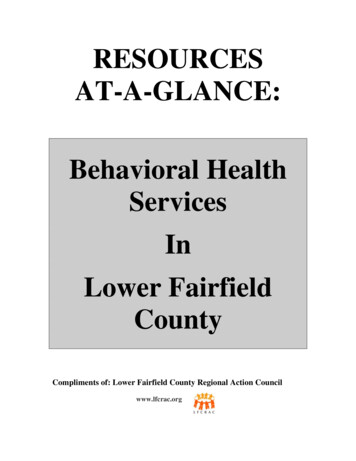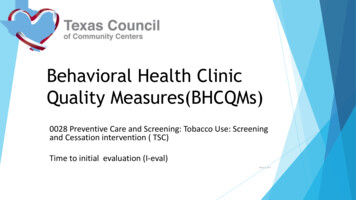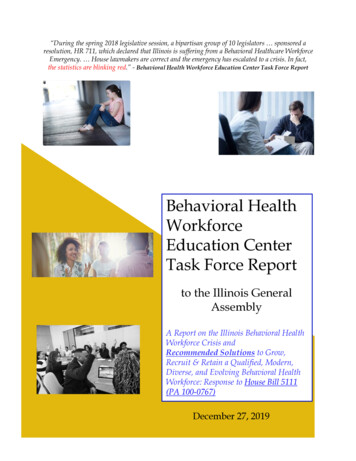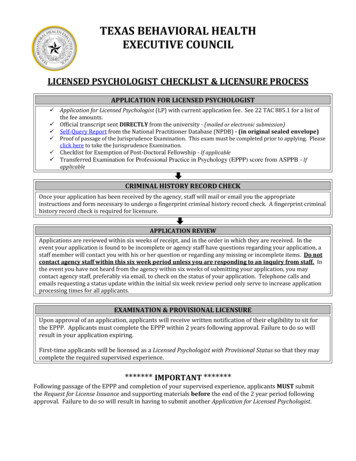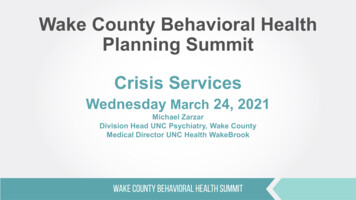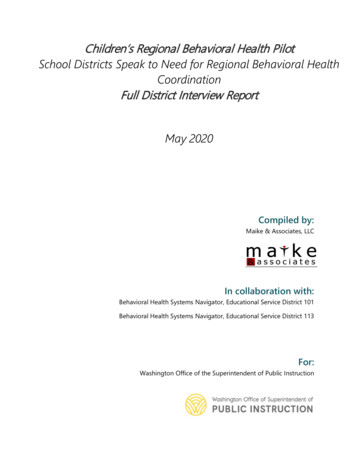
Transcription
Children’s Regional Behavioral Health PilotSchool Districts Speak to Need for Regional Behavioral HealthCoordinationFull District Interview ReportMay 2020Compiled by:Maike & Associates, LLCIn collaboration with:Behavioral Health Systems Navigator, Educational Service District 101Behavioral Health Systems Navigator, Educational Service District 113For:Washington Office of the Superintendent of Public Instruction
Table of ContentsAcknowledgements . 2Executive Summary. 3Introduction . 3Interview Methodology . 4Definitions . 5Educational Service District Interview Regions . 7What We Found . 8School-based Mental Health Supports Best Practices. 9What does access to school-based behavioral health care look like? . 12An in depth look at school-based behavioral health service . 13Awareness & Prevention . 20What do districts need to increase access to school-based behavioral healthcare for theirstudents? . 22Navigator Reflections. 24The ongoing work of the Behavioral Health Systems Navigators . 27Appendix A . 28Appendix B. 33Page 1 of 36
AcknowledgementsThe main component of this work was to conduct in-depth interviews with school districts inthe Educational Service District (ESD) 101 and Educational Service District (ESD) 113 regions tobetter understand the nature, depth, and breadth of current school-based social, emotionaland behavioral health strategies, as well as to identify barriers facing school districts as they tryto meet the behavioral health needs of their students.Thank you to all the participants who generously and graciously gave their time to this project.Each district represented participated in a 60-minute interview and provided a vast amount ofhonest and thoughtful insight about the state of school-based mental health services andsupports within their district.Participating od CanalOakvilleSpokane PublicSchoolsAlmiraHoquiamOcostaSpragueBengeKettle FallsOdessaSummit ValleyBoisfortLake QuinaultOlympiaTaholahCentral raliaLoon LakeOnion CreekTeninoChehalisMary M KnightOrchard PrairieToledoCheneyMary biaMeadPioneerWaHeLutCosmopolisMedical LakePullmanWellpinitCurlewMontesanoRainierWest ValleyCusickMortonRaymondWhite PassDeer ParkMossyrockReardan-EdwallWilbur-CrestonEast ValleyNapavineRepublicWillapa ValleyPage 2 of 36
ElmaNewportRiversideWinlockEvalineNine Mile FallsRochesterWishkah ValleyFreemanNorth BeachSatsopYelmGarfield-PalouseNorth RiverSelkirkGrapevineNorth ThurstonSheltonGreat NorthernNorthportSouth BendAnd a special thank you to the two pilot Regional Behavioral Health Systems Navigators,Andrew Bingham (ESD 101) and Grace Burkhart (ESD 113) for their time and commitment inconducting and recording these interviews.Executive SummaryIn the fall of 2019, as part of the Children’s Regional Behavioral Health Pilot Project (est. 2017),the Behavioral Health System Navigators (Navigators) in ESD 101 and 113 conducted in-depthinterviews with 85 school districts across their regions. The intent of the interview was tobetter understand the behavioral health systems in place in school districts, the extent towhich these systems were effective, and in what ways these might be improved.Through this interview process, the Navigators were able to unearth a multitude of complexbarriers facing districts as they try to meet the behavioral health needs of their students.Findings from interviews revealed that in a majority (77%) of these districts some form ofschool-based behavioral health services existed. However, access to services varied greatly; notonly in terms of availability of services, but also regarding service eligibility. Most districts(93%) also acknowledged their current system was not sufficient to meet the behavioral healthneeds of their students.The overarching purpose of the Children’s Behavioral Health pilot project was to investigatethe benefits of an ESD-level Navigator, with the goal to increase access to behavioral healthservices and supports for students and families. Results demonstrate that through relationshipbuilding and coordination, Navigators help bridge the gap between the behavioral health andK–12 education systems. Thereby, addressing systemic barriers to the delivery of school basedbehavioral health services and ultimately increasing access to care for youth and families.IntroductionIn 2017, the Legislature passed House Bill 1713 (2017–18) establishing the Children’s RegionalBehavioral Health Pilot Project. The purpose of the pilot project was to investigate the benefitsof an ESD Behavioral Health System Navigator (Navigator), with the goal to increase access toPage 3 of 36
behavioral health services and supports for students and families. The role of the Navigator isto integrate the behavioral health and K–12 education systems; thus, bridging the gapbetween these two systems. The Navigator is not a direct service provider, they connect andtranslate across the two systems in their respective regions. Northeast Washington ESD 101and Capital Region ESD 113 piloted this project through June 30, 2020.Since the pilot launched in July 2017, we learned several valuable lessons regarding the role ofthe Navigator as well as the ways in which the education and health care systems interact, andwe wanted to gather data about what we had learned from districts in conversations we hadthroughout the pilot project. Prior to the project, it was assumed that K–12 schools effectivelyused Medicaid reimbursement to expand healthcare services to students. Our findings,however, show that most schools do not effectively use this funding mechanism in large partbecause the Medicaid system is complex and burdensome to navigate.A second assumption was that Medicaid billing is readily accessible to schools—it is not.However, through our work, we have documented the tangled pathways to reimbursement.We now understand that these pathways are dictated by provider types, the kinds of servicesdelivered, and regional Managed Care Organizations and provider networks. These pathwaysare complex and challenging for schools to utilize.We also learned that a dedicated staff person working regionally within school districts canincrease access to care for students eligible for Medicaid by improving districts’ ability tonavigate the complexities of the Medicaid system, and the healthcare system in general. Tobegin to increase access to care in the school setting, requires not only collaborativepartnerships but also support from the entire K–12 system. This includes leadership at thestate level from the Office of Superintendent of Public Instruction (OSPI) and oversight andmanagement by the ESDs at the regional level, who in turn support the Navigators to helpschool districts at the local level successfully engage with healthcare system partners.Through the collective knowledge gained in the first project period about the school-basedMedicaid program, the publicly-funded regional healthcare structures, and the interaction ofthese within the K–12 education system, we identified the next level of information needed tofurther inform us about how districts strive to meet the needs of students’ behavioralhealthcare concerns. With the support of the Navigators, we designed a methodical andsystematic approach for interviewing each district about their needs, the systems in place tomeet those needs, and if existing systems were enough to address identified needs.Interview MethodologyIn the fall of 2019, the pilot Navigators conducted district-level interviews. The purpose of theinterview process was to better understand existing behavioral health systems in place inschool districts and their regions, including if these systems were effective, and in what waysthese might be improved. The interview process was designed collaboratively among projectPage 4 of 36
partners (OSPI, Navigators, and Research Partner). Questions were based on knowledge ofschool-based behavioral healthcare services and best practices for implementingcomprehensive school-based mental health systems (See Appendix A for Interview Questions).The interview was designed, in part, to delve further into lessons learned from the 2016 JointLegislative Audit and Review Committee (JLARC) Student Mental Health Services Inventory,while also informing our current work.As part of this effort, each Navigator made initial contact with the districts in their region, firstvia email, with follow-up conducted by phone. Interviews were conducted in-person, via videoconference, or by phone during the period of September 9th, 2019 to December 30th, 2019.Most (80%) interviews were conducted with a district administrator, primarily thesuperintendent/asst. superintendent or a building principal. The remaining interviews wereconducted with other, or multiple school staff such as a school counselor, licensed mentalhealth clinician, school social worker, or other administrative staff (e.g. Director of StudentSupport).Interview responses were documented by the Navigator at the time of interview. Notes weretranscribed and sent to the Research Partner for analysis. Using an online platform(SurveyGizmo), interview responses were transferred to a database, and exported into an excelworkbook for analysis. Analysis included a summarization of responses by ESD region, andclass size as well as qualitative analysis of open-ended interview responses. Specific dataanalysis methods can be found in Appendix B.DefinitionsOne of the early learnings during this project is the importance of establishing a commonterminology.How the education and healthcare systems talk about behavioral healthcare inschools is very different, and because of these differences, confusion about needs,and how schools are meeting those needs can occur.With this lesson in mind, and to ensure a common language, the following definitions wereestablished by the project team and reviewed with each participant prior to the interview: Behavioral Health or Behavioral Healthcare means mental health and substance useprevention, intervention, and treatment.Comprehensive School Mental Health Program means there is a full array of tieredsupports and services that promote positive school climate, social and emotionallearning, and mental health and well-being, while reducing the prevalence and severityof mental illness and substance use issues.Page 5 of 36
School-based Behavioral Health Services refers to both mental health and substanceabuse prevention and intervention strategies delivered in the school-setting (i.e.students have access to services at the school building, during school hours. Servicesmay be provided by community-based/outside providers and/or a district-hired MHprovider or district staff (e.g. nurses, counselors, psychologists, social workers, etc.).Community-based Behavioral Health Services, like school-based services, but theseare delivered in the community-setting. (i.e. services that are not located in schoolbuilding but may be available for students in need).Although these definitions were included as part of the process, we came to understand thateach participant came to the interview with their own understanding of these systems; thus,responses reflected the lens from which they observed their system, with these observationsbased on previous knowledge, expertise, and position within the education system (e.g.superintendent versus school counselor).Page 6 of 36
Educational Service District Interview RegionsCapital Region Educational ServiceDistrict (ESD) 113 is located on thewestern side of the state, based inTumwater, WA. ESD 113 supports 45 schooldistricts across five counties: Grays Harbor,Lewis, Mason, Pacific, and Thurston. Schooldistricts in this region range in size from 50to 15,000 students, with Class 1 districtsaccounting for approximately 20% ofdistricts. ESD 113 represents a totalstudent population of 73,000.Since 1998, the ESD has been a Washingtonstate licensed outpatient substance usetreatment disorder provider, adding mentalhealth treatment and establishingthemselves as a licensed behavioral healthagency in 2014. As such, the ESD came tothe pilot project with experience inproviding direct behavioral health servicesin both the clinical and school settings, aswell as existing relationships with schooldistricts and other community partnersthrough their existing services.Northeast Washington Educational ServiceDistrict (ESD) 101 is located on the eastern sideof the state and is based in Spokane, WA. ESD 101supports 59 school districts across 7 counties:Adams, Ferry, Lincoln, Pend Oreille, Spokane,Stevens, and Whitman covers the largestgeographic region of the nine ESDs in the state(14,026 square miles). Districts within the ESD 101region range in size from 20 to 31,000 students,with Class 2 districts comprising approximately80% of districts. However, it is important to alsonote that nearly half (48%) of the Class 2 districtsin this region have a student population below200, most of which are also geographicallyisolated. ESD 101 represents a total studentpopulation of 101,382.Across these two ESD regions a total of 88ESD 101 is not a licensed behavioral healthindividual district-level interviews wereprovider, however, is in the process of pursuingconducted, representing 98% of ESD 113licensure at the time of this report (April 2020).districts and 75% of ESD 101 districts, with aregionwide student population of 167,819(OSPI, 2012-2020). The following data represents 85 district entities. 11In ESD 101, the following districts were combined into one interview entry: Wilbur-Creston, Garfield-Palouse, Lind-Ritzville.Page 7 of 36
Of these 85 districts, Class 1 districts (i.e.,districts with more than 2,000 students)represented 20% of interviewees (n 17),with the remaining 80% Class 2 districts(n 68) (i.e., district with less than 2,000students).The proportion of Class 1 and Class 2 districts was similar across the two ESDs.2What We FoundOverall, 66 (77%) districts reported students had access to some form of school-basedbehavioral health services (SBBHS). However, nearly all districts (93%) also reported that theircurrent system was not sufficient to meet the behavioral health needs of their students.Findings indicate that 100% ofClass 1 districts and 72% of Class 2districts reported access to schoolbased behavioral health services.However, as the followinginformation illustrates, whatdistricts described as school-basedbehavioral health services variedwidely.TABLE 2: Number of Districts w/School-based BHServices by ESD Region and ClassYESNOTotalESD 101ESD 113Class 1Class 2Total329413410441701749196866 (77%)19 (23%)85 (100%)In fact, many larger districts had one or multiple providers spread across their districts invarious buildings and grade levels delivering direct services from one to several days per week.Among the smaller districts, participants also indicated that service providers were on site aspecified number of days, however, due to eligibility criteria and provider schedules, serviceswere not always consistently delivered (e.g., weekly).These variations in service delivery models illustrate a gap between known best practices (asdefined below) in a comprehensive school-based mental health services and supports systemand those available to students in schools, with these disparities acknowledged by the districtsthemselves.For example, one district described their school-based behavioral health services program as:“Different counselors through [Provider]. Specific counselors with different positions andcredentials who see students. Don't seem to be specific to youth or have very much experienceserving children Communication is not always great, definitely room for improvement. We2Class 2 districts comprise 64% (188) of the 295 districts in the State. ome/Document/183987Page 8 of 36
provide an office space for them to meet students, the counselor refers students to them. Nointakes here at the school, they go to [Provider] to have an intake for services.” – ESD 101, Class2On the other hand, another district described their system as having “school counselors [that]are certificated, and some of them have active licenses or previous licenses as a treatmentprovider. They provide individual work, family, group, instructions in the classroom,training/information for the staff.” ESD 101, Class 1, alluding to a more formalized system thanthe example given above.For another “We have a private therapist who comes up to us 2-3 days a week to see kids. Sheis a licensed mental health counselor in [City] and we pay her a sub fee for her service. She isreally just being generous, and we can’t afford to keep her. She is leaving at the end of the year.”– ESD 113, Class 2As noted, results revealed that although most districts reported having school-basedbehavioral health services in place, these services fall short of meeting best practice standards.In fact, our findings suggest that there is a significant gap between the perceived (or reported)state of school-based behavioral health services and the recommended (or preferred) state ofschool-based behavioral health services across these districts.School-based Mental Health Supports Best Practices 3School-based mental health supports are defined as mental health promotion, education, andthe continuum of mental health services—prevention, assessment, intervention, treatment,consultation, and follow-up. These services andIn their words supports are provided in a school setting, through the“Funding is number one, we have none.collaboration of the school district’s student supportFinding a licensed treatment provider whoservices and the school-based and/or communityis talented and qualified to meet thebased mental health system, in partnership with youthneeds of our kids
Grapevine North Thurston Shelton Great Northern Northport South Bend . And a special thank you to the two pilot Regional Behavioral Health Systems Navigators, . behavioral health services and supports for students and families. The role of the Navigator is to integrate the behavioral health
